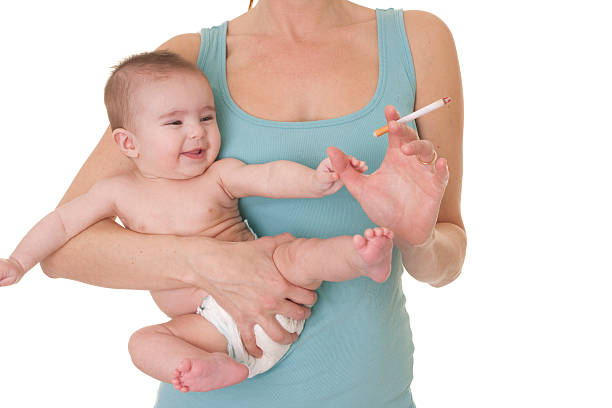Each mother puts breastfeeding as their number one priority, to provide the best nutrition and care for their baby. If you are a smoker or regularly around smoking, you may wonder if you can Breastfeed. The short answer is: Neither is it an absolute contraindication to smoking and breastfeeding. You’ll need to learn how smoking will affect you and your baby, and how to cut your risks if you don’t stop smoking straight away.
Effects of Smoking on Breastfeeding

Cigarette smoking can cause nicotine — the primary addictive substance in cigarettes — to pass into breast milk. A lot of that is problematic because it can actually reduce milk production and can also change what we are actually getting into the milk by itself. Studies show smoking mothers may produce as little as 25 percent less breast milk than non smoking mothers because nicotine lowers prolactin, the hormone that triggers milk production.
Babies exposed to nicotine via breast milk may also manifest colic, restlessness and sleep difficulties. Babies will find nicotine harder to settle down and may become fussier and suffer disrupted sleep patterns as a result. Also, smoking decreases fat in breast milk, which, if lower than normal, can mean your baby is getting less nutritious breast milk.
Health Risks for the Baby
Serving as another reason to breastfeed, breastfeeding enhances immunity and reduces risks of infection for babies. But when a mother smokes, these benefits can be undone. Breathing in secondhand smoke makes babies more likely to get respiratory infections, asthma, ear infections and even sudden infant death syndrome (SIDS). Transferring nicotine and other harmful chemicals from tobacco smoke to babies through breast milk also puts them at risk for extra health risks.
Other toxins, like carbon monoxide and nicotine, can linger in the air around your own home — affecting you and your baby. Cigarette smoke contains harmful chemicals that can suppress a baby’s immune system and thereby make the baby more prone to illnesses. Infants of smokers are more likely to contract chest infections, bronchitis and other respiratory problems than babies with parents who don’t smoke.
Can You Still Breastfeed if You Smoke?

While giving up smoking is the best thing for mother and baby, breastfeeding is better for smoking mothers than formula feeding, health professionals say. While there is a risk to nicotine, breast milk continues to provide many benefits, such as essential nutrients and antibodies that will help protect your infant from a wide range of diseases.
According to the Centers for Disease Control and Prevention (CDC), mothers smoking shouldn’t quit nursing and should do what they can to reduce the child’s exposure to nicotine. In general, breastfeeding is healthier than smoking, so long as your baby’s exposure to smoke is reduced.
Ways to Reduce Risk
If quitting smoking isn’t an option immediately, there are several ways you can reduce the impact of smoking on breastfeeding:
- Time Your Smoking Sessions: Instead of smoking immediately after breastfeeding try and smoke before, giving your body more time to metabolize nicotine so it is ready for the next feeding session. Breast milk nicotine levels fall over time, and waiting 90–120 minutes between smoking and breastfeeding lowers your baby’s nicotine intake.
- Smoke Away from the Baby: Never smoke near your baby. Just as bad, if not worse, than smoking your child inhales secondhand smoke, so be sure to smoke outside or at least in a well ventilated area when you do. In addition to secondhand smoke, which lingers on clothes, hair and furniture, thirdhand smoke is also dangerous, so you ought to wash your hands and change your clothing after you smoke.
- Limit Your Cigarette Consumption: The lower the amount of cigarettes you smoke, the lower the nicotine levels in your breast milk. Cutting down on how many cigarettes you smoke can reduce how much nicotine affects your baby’s health.
- Consider Nicotine Replacement Therapy (NRT): However, nicotine patches or gum are not totally risk free, but may provide a less risky option to smoking than smoking, because nicotine patches or gum contain fewer toxic chemicals than tobacco smoke. Bear in mind though, though, that you should never use NRT without first speaking with your healthcare provider if you’re breastfeeding.
- Quitting Gradually: And that even cutting down can reduce risks significantly. Many resources are now available to help you through this difficult quit smoking transition, but speak to a healthcare professional for support.
What If You Can’t Quit?
But for mothers who can’t quit smoking, breastfeeding remains better for the baby than switching to formula. Breast milk antibodies and nutrients are protective, something you can’t replicate with formula. But in doing so, you should take every step to try to limit your baby’s exposure to nicotine and second hand smoke.
Impact on Milk Supply
It can also hurt your ability to breastfeed directly by reducing your milk supply. The reason is that nicotine affects prolactin—needed to produce milk. Smoking may make it difficult for mothers to generate sufficient milk for breastfeeding, especially when baby comes quickly.
If you have low milk supply, it is best to get help from a lactation consultant in terms of tips on increasing milk production. There are some strategies: frequent feeding, staying hydrated, use breast pumps to encourage milk flow.
Long-Term Effects on the Child
Infants exposed to nicotine and cigarette smoke are at risk for long term health problems. That may entail an upped susceptibility to respiratory condition, behavioral problems, and even delays in development. Mothers must understand that while smoking during the early days of breastfeeding can be bad news for the mother, it can also have detrimental effects on the health and well being of the child as he or she grows.
Studies also have suggested a possible connection between smoking while breastfeeding and behavioral problems with hyperactivity or attention in later childhood. It points out the need to combat smoking and all its concomitants on the earliest possible date.
Secondhand and Thirdhand Smoke Risks

Secondhand smoke, or passive smoking, is the smoke inhaled by people around a smoker or smoked from the burning end of a cigarette. But babies who breathe in secondhand smoke are more likely to develop respiratory problems, including asthma and bronchitis. Secondhand smoke has also been associated with a heightened risk of SIDS, an issue of enormous import to any parent.
Thirdhand smoke means internally, on surfaces that other people have smoked. In addition, these fetal microbial exposures can become trapped on clothing, furniture and skin, further posing an elevated risk for babies who may accidentally eat the harmful particles while playing or nursing.
Support for Quitting Smoking
It’s hard to quit smoking, but breastfeeding moms who want to quit can get a wealth of support. There are resources, such as counseling, support groups and smoking cessation programs, which many healthcare providers give. While you can’t smoke while breastfeeding, you can work with a healthcare provider to help create a plan that supports your breastfeeding goals and your attempt to give up smoking.
The truth is, whether quitting smoking improves your health or your baby’s, it’s going to happen regardless. The better off it is for both of you, the sooner you quit.
Conclusion
There is a lot of smoking and breastfeeding to consider. As you can imagine, pregnancy is a bad time to start smoking, but the risks of breastfeeding with a baby who is also exposed to nicotine are outweighed by the benefits and a few simple precautions can help reduce the amount of smoke in the air your baby breathes. The best thing to do is to quit smoking … but if quitting isn’t immediately possible, things such as limiting the number of cigarettes smoked, timing the smoking sessions around your baby, and taking smoking away from your baby … will help reign in the risks. As you work on smoking cessation, seek to always receive support from healthcare professionals as you begin the journey of breastfeeding.


